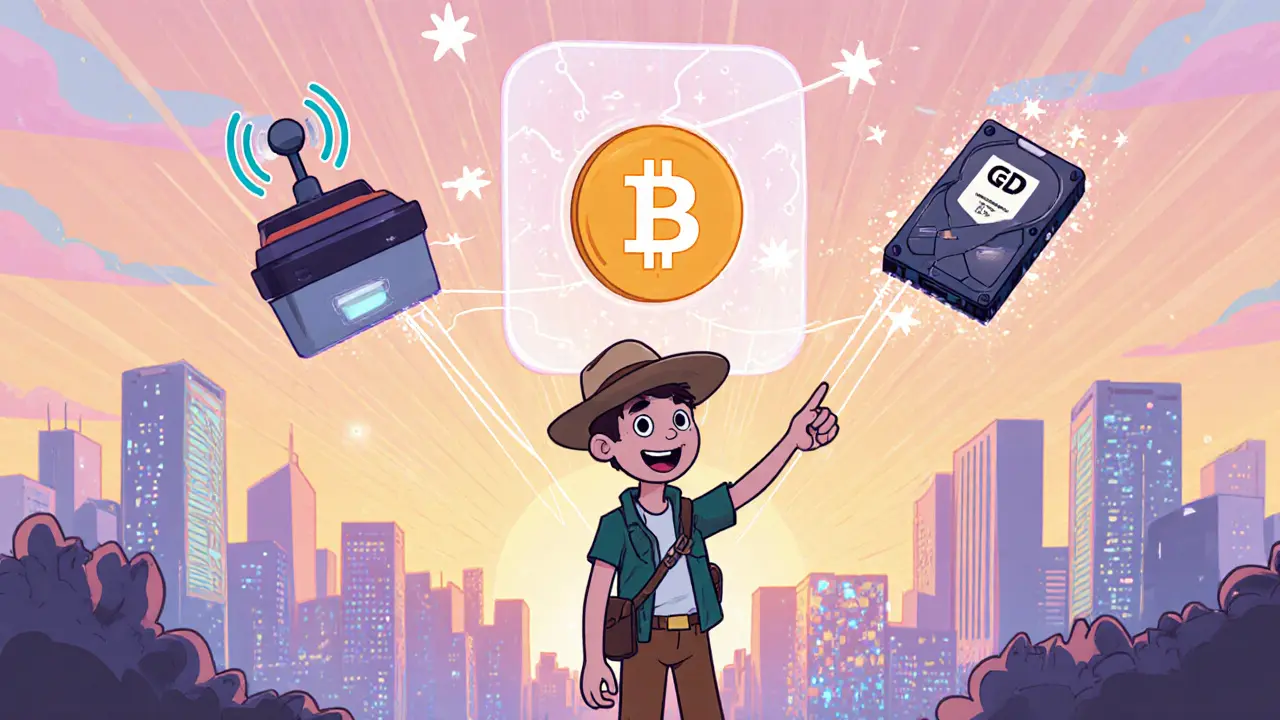DePIN Investment Calculator
DePIN Project Evaluation
Calculate potential returns and risks for your DePIN investment strategy
If you're eyeing DePIN investment opportunities, you’ve landed in the right spot. Decentralized Physical Infrastructure Networks are reshaping how real‑world services-wireless coverage, data storage, mapping-are built and monetized. This guide walks through the key factors you need to decide whether a DePIN project belongs in your portfolio.
What Exactly Is a DePIN?
Decentralized Physical Infrastructure Networks (DePIN) are blockchain‑based systems that incentivize individuals to provide physical resources-like radio antennas, storage drives, or GPU power-in exchange for native tokens. Smart contracts verify service delivery, automate rewards, and keep the ledger transparent. The model emerged in 2022 after blockchain proved viable beyond finance, and early pilots such as Helium and Filecoin showed that community‑owned infrastructure can compete with traditional monopolies.
Why DePINs Matter for Investors
Three compelling reasons set DePINs apart from typical crypto assets:
- Real‑world utility: Tokens are tied to measurable services-hotspot coverage, stored bytes, mapped miles-making demand easier to track than pure speculation.
- Cost advantage: Crowdsourced capital can cut deployment expenses by 30‑50% versus legacy providers, according to a16z Crypto’s 2023 analysis.
- Network effects: As more participants join, service quality improves, attracting more users and driving token appreciation-a potential trillion‑dollar upside cited by Chris Dixon.
Two Main DePIN Categories
Understanding the split between Physical Resource Networks (PRNs) and Digital Resource Networks (DRNs) helps you match risk tolerance with investment style.
Helium exemplifies a PRN: owners buy a hotspot (typically $100‑$300) that broadcasts LoRaWAN signals and earns HNT tokens based on data traffic. In contrast, Filecoin is a DRN, where users lease hard‑drive space and earn FIL tokens without any dedicated hardware purchase.
| Aspect | Physical Resource Networks (PRN) | Digital Resource Networks (DRN) |
|---|---|---|
| Entry Cost | $100‑$1,000 per node (hardware) | Low‑cost (existing compute/storage) |
| Regulatory Exposure | High (spectrum licenses, safety standards) | Moderate (data privacy, energy usage) |
| Scalability | Depends on physical rollout | Can scale virtually across clouds |
| Typical ROI Timeline | 6‑12 months (depending on traffic) | 3‑9 months (storage/compute demand) |
| Examples | Helium, Hivemapper, Helium Mobile | Filecoin, Render Network, Arweave |
Top DePIN Projects to Watch in 2025
The market now hosts over 50 active networks, but a handful dominate activity and funding.
- Helium - Decentralized wireless with >1 million hotspots, migrating to Solana to slash fees.
- Filecoin - Decentralized storage, newly launched Filecoin Virtual Machine (FVM) boosting developer interest.
- Hivemapper - Crowdsourced street‑level mapping, earning tokens for miles driven.
- Render Network - Distributed GPU rendering, processing >1.2 million jobs in Q2 2023.
- Polygon - While primarily a layer‑2 blockchain, its low‑cost environment powers many DePIN smart contracts.
These projects collectively hold roughly $2.4 billion of market cap, representing 75% of total DePIN valuation.
How to Evaluate a DePIN Project
Apply a three‑step checklist before committing capital.
- Token Utility - Does the token serve a clear purpose (payment, staking, governance) beyond speculation? Projects with clear utility tend to survive token‑inflation pressure.
- Verifiable Real‑World Metrics - Look for on‑chain or API‑published data: hotspot count, stored terabytes, rendering jobs, or miles mapped. Transparent metrics reduce the “verification problem” highlighted by a16z.
- Emission Schedule - Sustainable tokenomics usually cap inflation under 5% after the initial distribution phase. Over‑generous emission can erode token value quickly.
Projects that score well across these dimensions often justify higher valuations.
Risk Factors You Can’t Ignore
Every promising sector carries downside. The biggest threats for DePINs include:
- Regulatory Uncertainty - Telecom spectrum rules, energy licensing, and data‑privacy laws can force abrupt token reward adjustments. Helium’s 2023 FCC‑mandated fee reduction cut hotspot earnings by 20%.
- Hardware Dependency - PRNs require reliable equipment. Early adopters reported 30% setup failures due to firmware incompatibility.
- Reward Volatility - As networks scale, per‑node earnings often decline; Helium’s daily hotspot reward fell from $1.50 in Q1 2022 to $0.35 by Q3 2023.
- Competition from Centralized Players - Big telcos are experimenting with blockchain‑enabled back‑haul solutions, potentially marginalizing community‑run networks.
Practical Ways to Get Involved
There are three main entry routes, each with its own learning curve and capital requirement.
- Token‑Only Position - Buy DePIN tokens (HNT, FIL, RNDR) on major exchanges. Requires understanding market timing, but no hardware.
- Deploy Physical Nodes - Purchase and install a hotspot or mapping device. Initial spend $100‑$1,000 plus electricity costs; expect 20‑30% annualized returns if location demand stays strong.
- Provide Digital Resources - Offer spare storage or GPU power to DRNs. Often the cheapest way to earn, but you need compatible hardware and bandwidth.
Most investors blend token‑only exposure with a single physical node to diversify risk while learning the verification process.

Tax and Compliance Considerations
Rewards are usually treated as ordinary income in the U.S., with 47 states imposing tax reporting obligations. Keep detailed logs of token receipts, hardware expenses, and electricity costs. Automated crypto tax software can simplify filing, but be aware that some jurisdictions still lack clear guidance for DePIN‑specific income.
Future Outlook - Where Is DePIN Heading?
Industry forecasts are bullish yet tempered by realism. a16z Crypto predicts DePIN could capture 5‑10% of global infrastructure value (up to $1 trillion) by 2030 if regulatory hurdles ease. Delphi Digital expects consolidation, with 70% of current projects merging or exiting by 2025, leaving a handful of “unicorn” networks to dominate.
Key catalysts for 2025‑2026 include:
- Helium’s Solana migration, expected to lower transaction fees by 80% and boost new hotspot adoption.
- Render Network’s expansion into AI model training, opening fresh demand for GPU cycles.
- Enterprise API rollouts from Hivemapper, targeting logistics firms and autonomous vehicle manufacturers.
- Polkadot’s DePIN parachain slots, funneling $45 million of developer funding into the ecosystem.
If those milestones hit, token price appreciation could outpace many traditional crypto sectors, making DePIN a compelling addition for forward‑looking portfolios.
Quick Checklist Before You Invest
- Verify token utility and inflation schedule.
- Check on‑chain service metrics (hotspot count, stored TB, rendered jobs).
- Assess regulatory landscape for the specific vertical (telecom, storage, energy).
- Calculate hardware ROI vs. token‑only exposure.
- Plan for tax reporting and compliance.
Frequently Asked Questions
What is the minimum hardware cost to start mining Helium hotspots?
A basic Helium hotspot kit typically costs between $150 and $300, plus electricity. Some users report higher upfront spend for outdoor‑rated enclosures.
Can I earn DePIN tokens without owning any physical devices?
Yes. Most projects list their tokens on exchanges, so you can buy and hold them. You’ll miss out on hardware‑based reward streams but still benefit from price appreciation.
How do DePIN projects verify real‑world service delivery?
Verification uses on‑chain oracles, signed payloads, and location proofs. For example, Helium hotspots broadcast a proof‑of‑coverage message that nearby devices confirm before rewards are issued.
What tax form should I use for DePIN earnings in the United States?
Treat token rewards as ordinary income on Form 1040 Schedule 1. Capital gains apply when you later sell the tokens.
Is DePIN a safer bet than traditional DeFi tokens?
DePIN offers tangible usage metrics, which can reduce price volatility. However, hardware risk and regulation add new layers of uncertainty not present in pure DeFi.

5 Comments
Cory Munoz
I've been running a Helium hotspot for 18 months now. The first few months were slow, but once my neighborhood started adding more nodes, rewards picked up. It's not a get-rich-quick thing, but it's nice to see something tangible you're helping build. Also, the community Discord is surprisingly helpful if you're new to this. 🤝
Jasmine Neo
DePIN is just crypto with extra steps. You're paying $300 for a box that earns you 35 cents a day? And you think that’s better than just buying ETH? The FCC already neutered Helium, and now you want to bet your life savings on more hardware that’ll become obsolete in 18 months? 🤡
Ron Murphy
Interesting breakdown, especially the PRN vs DRN comparison. I’ve been eyeing Render Network because I’ve got a spare RTX 3080 gathering dust. The 1.2M jobs stat is legit-checked their dashboard last week. Still, the tokenomics feel a bit aggressive. 7% inflation post-launch? That’s a red flag unless demand keeps exploding. Might wait for the AI training push to materialize before pulling the trigger.
Prateek Kumar Mondal
Filecoin and Hivemapper are the real plays. No hardware needed for Filecoin if you have cloud storage. Hivemapper lets you earn while driving. Simple. No hype. Just utility. 2025 will be the year it clicks for mainstream
Nick Cooney
Wait so you’re telling me I should buy a $300 hotspot... but not actually *use* it for internet? Like... it’s just a tax write-off with Bluetooth? 🤔 Also, I just checked my tax software-it says my HNT rewards are ‘miscellaneous income’... which means I have to file a 1099 for $12.78? The system is broken. But hey, at least it’s decentralized, right? 😏